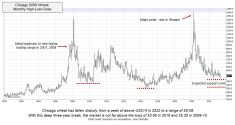Over the past couple weeks, limited harvest progress has occurred in Ontario due to adverse weather. Soybean harvest progress was estimated at 93 per cent complete as of Dec. 1; farmers had about 75 per cent of the corn crop in storage.
Farmers have been active sellers of corn and soybeans, which has tempered the upside for Ontario cash prices. At the same time, commercial stocks are manageable due to the year-over-year increase in exports of corn, soybeans and wheat.
The weaker Canadian dollar has contributed to the stronger export pace. We’re expecting the Canadian dollar to remain under pressure as the United States interest rate premium over Canadian rates continues to widen. The U.S. dollar has once again become a safe haven mechanism. Favourable U.S. economic data continues to support the U.S. dollar while other major G7 economies experience slower growth.
Read Also

Have the wheat bear markets run their course?
Wheat futures keep trying to rally. Time after time, the rallies fail. The markets seem stuck in low-level ruts.
U.S. President Donald Trump and Chinese President Xi Jinping met after the G20 summit in Argentina. Apparently, Trump has stated no additional tariffs on Chinese goods will be implemented on Jan. 1. Negotiations between the U.S. and China will be ongoing. It’s status quo for the time being and it appears there will be no escalation in tariffs on either side.
Quick look
Soybeans: U.S. farmers are likely to be aggressive sellers late next year.
Corn: Canadian corn exports, mostly from Ontario, have more than doubled this year over last.
Wheat: The U.S. soft red winter wheat crop had quality issues enhancing value for the Ontario crop.
Soybeans
The Chinese tariffs on U.S. soybeans have altered traditional trade flows. U.S. soybeans have traded in Argentina and Brazil as the two major South American countries struggle to satisfy Chinese demand.
U.S. soybean export commitments were 23.3 million tonnes on the latest export sales report which is down 32 per cent from last year. It’s also important to remember that Argentina experienced a minor drought last year resulting in year-over-year decrease in soybean production. Argentina is the world’s largest soymeal exporter and they’ll maintain that position with the help of U.S. soybean imports. While U.S. soybean sales are lagging year-ago levels, export commitments of soymeal are actually ahead of last year by 16 per cent. U.S. soyoil sale commitments are also up from year-ago levels. We have to remember that the U.S. experienced two historically large soybean crops in a row.
Argentine soybean planting is about 44 per cent complete while Brazilian farmers are in the final stages. Weather conditions have been optimal in Brazil and the U.S. Department of Agriculture forecasts the crop to finish at 120.5 million tonnes, up slightly from the 2018 harvest of 119.8 million tonnes. Argentinean soybean production is projected to finish at 55.5 million tonnes, up from last year’s drought-hindered crop of 37.8 million tonnes.
All three major exporters are contending with large supplies and the Chinese trade tariffs only add a thorn into the equation. Brazilian soybeans will come on the world market in late January and early February. Even if China does make some concessions on the U.S. soybean tariffs, there will be stiff competition from all three major exporters. Chinese buyers have tempered old crop Brazilian purchases stretching out supplies until new crop. Unless we see adverse weather develop in South America, don’t expect much upside in Ontario soybean prices.
What to do: We’ve advised Ontario farmers to be 80 per cent to 90 per cent sold on their 2018 production. We advised farmers to sell their first 20 per cent increment of their 2019 crop. The U.S. farmer is going to be an aggressive seller in the latter half of the year.
Next spring, U.S. farmers will likely decrease soybean acres at the expense of corn. However, with the record large ending stocks and year-over-year increase in South American production, there’ll be no shortage of soybeans.
Corn
The corn market is slightly higher due to strong export demand and the weaker Canadian dollar. Canadian crop year-to-date exports for the week ending Nov. 25 were 408,000 tonnes, up from 153,500 tonnes last year. Most of these exports are from Ontario because Western Canada is a net importer of U.S. corn due to the tight barley fundamentals.
Bids from ethanol producers are slightly higher this week as well despite the weaker crude oil futures. Another factor to consider is that the amount of corn with high vomitoxin is unknown and it is a major problem this year in certain regions of Ontario. The cash corn market appears to be incorporating a small risk premium due to the uncertainty in usable supplies. Ontario domestic feed demand is moving through a seasonal high as feedlots fill up with inventory. Cattle-on-feed inventories tend to make a seasonal high in late winter.
The Chinese tariffs on U.S. corn do not directly affect the corn market but they stem the exports of sorghum and dried distiller grains. The U.S. hasn’t found alternative homes to totally offset the Chinese tariffs, therefore, U.S. corn demand for domestic feed use is coming in lower than expected. U.S. corn export sales commitments are running about 16 per cent ahead of year-ago levels, which is offsetting the lower-than-expected domestic feed demand.
The news from Argentina is mixed with corn seeding progress estimated in the range of 40 per cent to 50 per cent complete.
Adverse wet weather has hindered seeding progress, which is behind normal. Brazilian farmers have wrapped up seeding of their first crop corn but the exportable surplus comes from the larger second crop corn, which will be seeded in February. South American crop estimates are somewhat premature at this stage because these crops are a long way from the bin.
What to do: In the previous issue, we advised farmers to be 35 per cent to 40 per cent sold on their 2018 corn crop. This week, we’re advising producers to move to 50 per cent sold on the 2018 crop. Producers should take advantage of the stronger cash prices.
Once the lakes freeze over, the market may soften until March. Export and domestic demand is moving through a seasonal high. By moving to 50 per cent sold, producers can feel comfortable depending on how the South American crops turn out. Next spring, the USDA is expected to announce a sharp year-over-year increase in U.S. corn acres. Larger U.S. new crop supplies will weigh on old-crop prices.
Wheat
Ontario soft red winter wheat prices were slightly higher this week, largely due to steady export demand and weakness in the Canadian dollar. Chicago wheat futures consolidated in early December, while Kansas hard red winter wheat futures have been under pressure. It’s important to note that U.S. soft red winter wheat exports are running slightly ahead of year-ago levels while U.S. hard red winter exports are lagging last year’s pace. This sets the tone for Ontario as well.
The U.S. soft red winter wheat crop also has some issue with quality enhancing demand for Ontario origin. U.S. soft red winter wheat bids out of the Gulf have been competitive on the world market so that the U.S. has actually sold a few cargoes to Egypt, the world’s largest wheat importer.
The Australian harvest is well underway and yields are coming off slightly better than anticipated. However, Australian wheat prices are above world values tempering their export sales for the time being. Australian wheat prices will slowly decline as harvest moves into the final stages. The Argentine harvest is moving into full swing and yields are coming off as expected. Argentine farmers have sold about 50 per cent of their production.
The Russian government has set a nominal goal for wheat exports around 33 million. Russia will likely reach about 25 million tonnes of exports by the end of 2018; therefore, it’s inevitable that their export pace will subside in the latter half of the crop year. This is the main factor supporting world values moving forward and will allow the world wheat market some breathing room.
We want to draw attention to the Chicago wheat March-May futures spread. In mid-November, this spread was trading at a 12 cent per bushel carry; on Nov. 30, the spread closed at a 5.5 cent per bushel carry. The futures spread reflects the “smart money” of commercial players. Available stocks are tightening and this is a bullish signal. We’ve also seen a narrowing of the March-May spreads on the Minneapolis and Kansas wheat futures. In Ontario, old crop soft red winter wheat prices are equivalent with new crop prices, also a bullish signal.
What to do: In the previous issue, we advised producers to move up to 40 per cent on their 2018 production. Given the futures and cash market spreads, we’re now friendly for soft red winter wheat prices and the overall wheat complex. World wheat prices are slightly higher in early December. Let’s see if the Ontario wheat market can rally 30 to 50 cents a bushel.















